Amish in Delaware: 2024 Guide (Dover Community) - Amish America (original) (raw)
Tiny Delaware is home to a single sizable, long-lived Amish settlement. Founded over 100 years ago, the community just outside state capital Dover continues to grow, despite land pressure. Today (2024), nearly 2,000 Amish live in the Dover Amish community.
- The Dover Amish Community
- Delaware Amish Businesses
- Unique Delaware Amish Buggies
- Future of the Delaware Amish
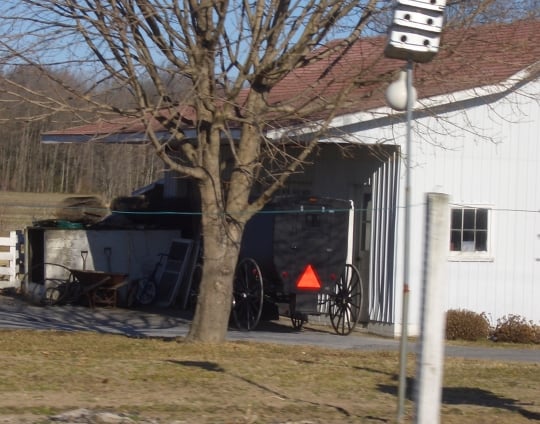
Only one Amish community is found in Delaware, outside of state capital Dover
Amish first settled in the middle of Kent County, the central county of the state’s three, in 1915. Settlers arrived here from states as diverse as Wisconsin, Montana, Alabama, and Ohio.
Today, the community numbers 14 church districts (congregations), with approximately 1,990 people, according to the latest figures from the Young Center at Elizabethtown College (PA).

Inside the kitchen of an Amish home in the Dover, DE community
The Dover community is one of a few truly “East Coast” communities, along with Lancaster County, the St. Mary’s County, Maryland Amish community, and a few others.
In fact – leaving out the atypical Pinecraft, Florida Amish community – the Dover group may be the most “coastal” of all, in the sense that they are within feasible buggying distance of the ocean.
At the Dover settlement, traditional plain white shutterless homes mix with suburban and rural English dwellings. Numerous buggy signs alert drivers to the presence of the Amish, cautioning vehicles to maintain low speeds when passing buggies.
Land pressure – from the state capital
The Amish at Dover are also close to another landmark of importance – the state capital. With suburban growth, the Amish community has found itself interspersed with large neighborhoods.
Fields of McMansions stand where corn once did, and a number of golf courses are found in the area. With the rise of settlement by non-Amish, road traffic inevitably increases as well.
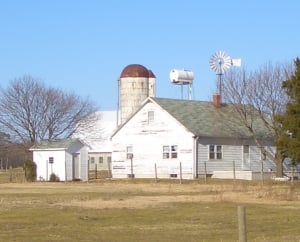
In Delaware, Amish farms have given way…
Years ago, the Dover Amish began leaving the settlement in significant numbers due to these pressures – with some no doubt enticed by the high land prices.
An Amish family here can sell its farmland and comfortably purchase one, two or even more farms in less-densely populated regions of the country.
Numerous Amish from Dover have migrated and started daughter settlements. One example of such community is the Halifax County, Virginia Amish group, or that at Burke’s Garden, Virginia.
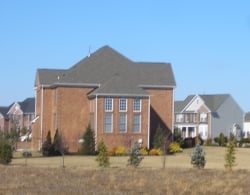
…to suburbs and golf courses
Realtor’s signs in some Amish yards as well as formerly Amish homes now wired for electricity are signs of such changes in the settlement.
As a result of the land situation, few Amish at Dover remain in full-time agriculture. The price of land in the area generally prohibits young men starting up in full-fledged dairy farming.
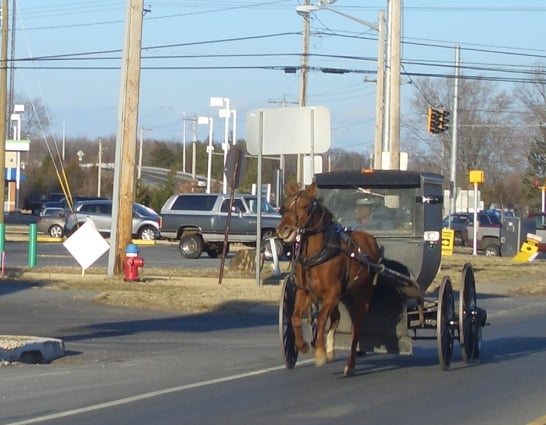
An Amish buggy on a busy road in the Dover community
High land prices may make some question why they continue to farm themselves. In fact, a number of those still owning large farms rent the land to be farmed by English farmers. In the early 2010s, a local Amish person estimated that only around 20 full-time Amish farmers remained.
Delaware Amish Businesses
While farming has dwindled, Amish have opened numerous businesses, consistent with the general trend in Amish society.
At the Dover settlement, Amish are involved in a number of trades typical among Amish people. They include furniture, buggy-making, blacksmithing, greenhouses, sawmills, and a number of shops, including dry goods, quilts, and appliance stores.
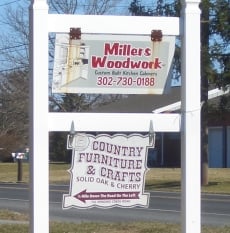
Amish furniture company signs in the Dover, Delaware settlement
Shops are typically located on-site at Amish homes, with roadside signs advertising their presence. As with all Amish, Dover businesses are closed on Sundays. Read more about Delaware Amish furniture businesses.
Unique Delaware Amish Buggies
The buggies driven by the Amish in Delaware are of particular interest due to their unique style. Dover buggies feature rounded sides, fully-opening back doors, and a generally bulky size. Other communities’ Amish buggies are more boxy in shape, or have angled, not curved sides.
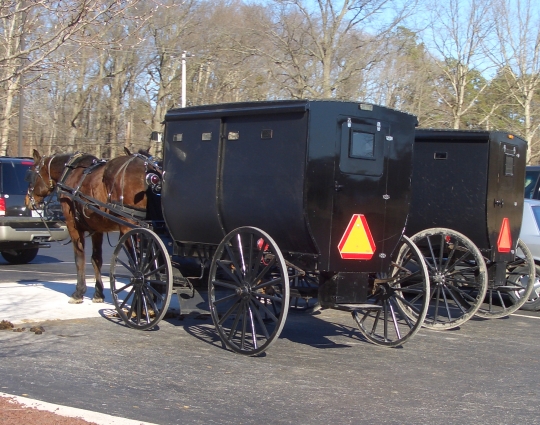
Characteristic Amish buggies parked in a lot in the Dover settlement
Some have likened the appearance of Delaware buggies (perhaps a bit tongue-in-cheek) to that of hearses. The distinctive look is seen only in the Dover community, and other Delaware Amish spin-off settlements.
Future of the Amish in Delaware
Amish settlements – even sizable ones – have gone “extinct” in the past, for a host of reasons. Despite land pressures, the Dover community remains sizeable.
The current estimated Amish population of just under 2,000 has Delaware ranking at #16 out of 32 states with Amish. The community has even continued to grow over the past decade, adding several church districts to the community.
This growth has gone again the trend seen in the early 2010s, when the first edition of this Delaware state guide was published on this website – a time when out-migration from the Dover community appeared to be going strong.
As for the state itself, given its small size and relatively high land prices, Delaware is not very likely to attract much additional Amish settlement. Besides the Dover community, there have been few if any other settlement attempts by Amish in the state.

A yellow warning sign alerts drivers to the presence of horse-drawn transport in Delaware’s sole Amish community
The general trend of Amish migration has been northward and westward. This is unlike in the early 1900s – when more of the country was up for agricultural development – and the first Amish settlers arrived in Delaware from diverse states in the West.
The Dover community has a long history, and though its proximity to the capital may continue to hamper its growth, it is not going anywhere. The trend of Amish from Dover starting new communities and/or settling in existing Dover daughter settlements is likely to continue, however.
Amish in the community are likely to find the best opportunities for growth by focusing future settlement westward, opposite from the expanding capital.
Occupations which don’t require large amounts of land – such as home businesses like furniture making or carpentry crews – also provide ways for Amish to make a living. These alternative occupations allow them to remain in the community without the large capital outlay that purchasing a dairy farm would require.
For more, see:
- “Amish Population in the United States by State and County, 2024” – Young Center for Anabaptist and Pietist Studies, Elizabethtown College
- “Amish Population, 2024” – Young Center for Anabaptist and Pietist Studies, Elizabethtown College
- A Visit to the Dover, DE Amish Community
- Inside A Delaware Amish Home (14 Photos)
- Delaware Amish Directory: 2005
